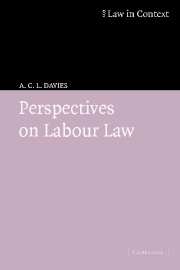Book contents
- Frontmatter
- Contents
- Preface
- Acknowledgements
- Table of statutes
- Table of statutory instruments
- Table of conventions and foreign legislation
- Table of cases
- Abbreviations
- Part I
- 1 A brief history of labour law
- 2 Economics perspectives on labour law
- 3 Human rights perspectives on labour law
- 4 Modes of regulation
- Part II
- What next?
- Index
4 - Modes of regulation
Published online by Cambridge University Press: 06 January 2010
- Frontmatter
- Contents
- Preface
- Acknowledgements
- Table of statutes
- Table of statutory instruments
- Table of conventions and foreign legislation
- Table of cases
- Abbreviations
- Part I
- 1 A brief history of labour law
- 2 Economics perspectives on labour law
- 3 Human rights perspectives on labour law
- 4 Modes of regulation
- Part II
- What next?
- Index
Summary
In this chapter, we will focus on the various modes of regulation in labour law: in other words, on the various different ways in which labour law is created and applied. You might think that this topic is too straightforward to merit a chapter to itself. Surely labour law is created by Parliament and applied by the courts? But matters are not so simple. It can no longer be argued that labour law is solely a matter for national governments. As we saw in the last chapter, some rights in the ECHR are relevant to labour law. These can now be enforced in the UK courts using the HRA 1998. Even more significantly, EU law (which takes priority over inconsistent national law) covers many aspects of employment, such as equal pay between men and women, collective consultation and the protection of atypical workers. Finally, the UK is bound in international law by ILO Conventions on important areas such as freedom of association and collective bargaining.
These various layers of regulation may come into conflict with each other. For example, the EU might propose legislation designed to promote workers' rights in a particular area – collective consultation, for example – but a UK government which was keen to reduce the regulatory burdens on businesses might be hostile to such legislation.
- Type
- Chapter
- Information
- Perspectives on Labour Law , pp. 54 - 72Publisher: Cambridge University PressPrint publication year: 2004

